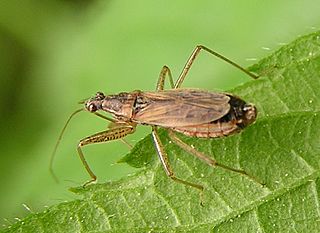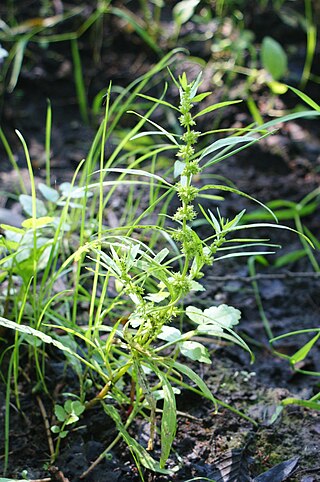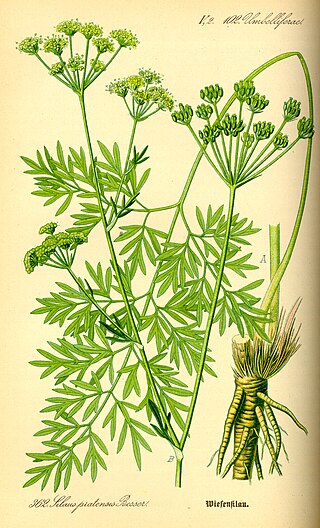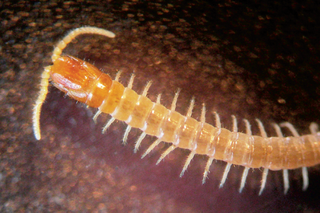
Elwendia persica is a plant species in the family Apiaceae. It is related to cumin and sometimes called black cumin, blackseed,, black caraway, and has a smoky, earthy taste. It is often confused with Nigella sativa, by which it is often substituted in cooking.

Enicocephalidae, also called unique-headed bugs and gnat bugs, are a family of around 300 species of the suborder heteroptera. They are typically 4 mm long, and found throughout the world. They have an elongated head, constricted in places, hence their head is 'unique'.

The insect family Nabidae contains the damsel bugs. There are over 500 species in 20 genera. They are soft-bodied, elongate, winged terrestrial predators. Many damsel bugs catch and hold prey with their forelegs, similar to mantids. They are considered helpful species in agriculture because of their predation on many types of crop pests.

Cerapteryx graminis, the antler moth, is a moth of the family Noctuidae. It is a common species throughout most of Europe but is lacking in the very dry southern regions. The northernmost occurrence is Iceland, and above the Arctic circle. It also occurs in Siberia and in North Mongolia. The species has been introduced to North America. In the Alps it rises to an altitude of 2100 meters.

Acanthophoenix is a genus of flowering plants in the palm family from the Mascarene Islands in the Indian Ocean, where they are commonly called palmiste rouge. A genus long in flux, three species are currently recognized, though unsustainable levels of harvesting for their edible palm hearts have brought them all to near extinction in habitat. They are closely related to the Tectiphiala and Deckenia genera, differing in the shape of the staminate flower. The name combines the Greek words for "thorn" and "date palm".

Anthocoridae is a family of bugs, commonly called minute pirate bugs or flower bugs. Worldwide there are 500-600 species.

The Machilidae are a family of insects belonging to the order Archaeognatha. There are around 250 described species worldwide. These insects are wingless, elongated and more or less cylindrical with a distinctive humped thorax and covered with tiny, close-fitting scales. The colour is usually grey or brown, sometimes intricately patterned. There are three "tails" at the rear of the abdomen: two cerci and a long central epiproct. They have large compound eyes, often meeting at a central point. They resemble the silverfish and the firebrat, which are from a different order, Zygentoma.

The Plutellidae are a family of moths commonly known as the diamondback moths, named after the diamondback moth of European origin. It was once considered to have three subfamilies: Plutellinae, Praydinae, and Scythropiinae. Praydinae was later elevated to its own family, Praydidae, while Scythropiinae has variously been moved to Yponomeutidae or also elevated to its own family.

Rumex palustris, or marsh dock, is a plant species of the genus Rumex, found in Europe. The species is a dicot belonging to the family Polygonaceae. The species epithet palustris is Latin for "of the marsh" which indicates its common habitat.
The Guadalcanal rat is a species of rodent in the family Muridae. It was found only in the Solomon Islands. Since this species was collected between 1886 and 1888 it has not been seen again. It is possibly extinct.

The whiskered treeswift is a species of bird in the family Hemiprocnidae. It is the smallest of 4 species in genus Hemiprocne and is found in Brunei, Indonesia, Malaysia, Myanmar, the Philippines, Singapore, and Thailand.

Crassula helmsii, known as swamp stonecrop or New Zealand pigmyweed, is an aquatic or semiterrestrial species of succulent plant in the family Crassulaceae. Originally found in Australia and New Zealand, it has been introduced around the world. In the United Kingdom, this plant is one of five introduced invasive aquatic plants that were banned from sale from April 2014, the first ban of its kind in the country. It is on the Global Register of Introduced and Invasive Species of eleven countries.
Sclerosperma is a monoecious genus of flowering plant in the palm family found in Africa where three species are known. Having no obvious relatives, it does resemble the Madagascar native Marojejya though a detailed study of Madagascar's palms is required to determine if any true relationship exists. The lack of relatives, and its interesting qualities, indicate, at one time, the existence of a diverse African palm flora. The name is from two Greek words meaning "hard" and "seed".

Silaum is a genus of flowering plants in the carrot/parsley family, Apiaceae. There are currently ten species placed into the genus, a list of which is provided below.

Mecistocephalidae are a monophyletic family of centipedes in the order Geophilomorpha. It is the only family in the suborder Placodesmata. Most species in this family live in tropical or subtropical regions, but some occur in temperate regions. This family is the third most diverse in the order Geophiliomorpha, with about 170 species, including about 130 species in the genus Mecistocephalus.

Monolepta is a genus of skeletonizing leaf beetles in the family Chrysomelidae. It is the most diverse and widely distributed genus in the Galerucinae sensu stricto, with more than 700 described species occurring almost worldwide. It is missing from the Nearctic realm.
Oryzaephilus genalis, is a species of silvan flat bark beetle native to India and Sri Lanka.
Agathidium jasperanum is a species of round fungus beetle in the family Leiodidae. This species is distinguishable from others in the group by the body somewhat elongate, the punctures on the head distinctly larger than those of pronotum, the elytral punctation coarser and denser than on head and pronotum and with some punctures more or less serially arranged, and the median lobe of the aedeagus elongate and narrow, with the apex slender and apically narrowly rounded. Its type locality is Jasper National Park, Alberta, hence the name.
Acanthogeophilus dentifer is the type species of the genus Acanthogeophilus found in the Italian peninsula. It is characterized by an absence of anterior tubercles on a forcipular coxosternum, smooth internal margin of forcipular tarsungulum, presence of basal tubercle on forcipular tarsungulum, and transversally elongate sternal pores on the posterior area.
Acanthogeophilus spiniger is a species of soil centipede in the family Geophilidae found in Northwest Africa. It was first assigned to the genus Geophilus, but was moved to Acanthogeophilus in 1999 by Foddai and Minelli. Like other species in its genus, it is characterized by incomplete chitin lines, complete coxopleural sutures, stout legs, and a claw-like pretarsus.














